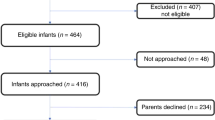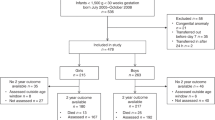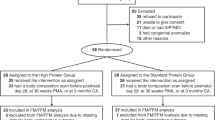Abstract
Background/Objective
To investigate impacts of early postnatal macronutrient intakes on growth and body composition of preterm infants within the first 6 months.
Subjects/Methods
One hundred and thirty-three very preterm (VPT) and/or very low birth weight (VLBW) infants were consecutively included. Enteral and parenteral macronutrient intakes during the first 28 days were recorded and average daily intakes were calculated. Growth was measured at birth, term age, and 6 months of corrected age (CA). Body composition was examined by air displacement plethysmograph at term age and 6 months of CA. Associations of nutrient intakes with growth and body composition over time were analyzed using generalized estimating equation.
Results
After adjusting for covariates, higher daily protein, lipid, and energy intake during the first 28 days was associated with higher weight at term age for every 1 g/kg/day increment of protein and lipid intake, and every 10 kcal/kg/day increment of energy intake was associated with 0.50 (95% CI 0.04, 0.96), 0.29 (95% CI 0.07, 0.51), and 0.27 (95% CI 0.10, 0.44) higher weight z-score, respectively. Higher protein intake was associated with lower z-score of fat mass (FM, β = −1.88, 95% CI −3.53, −0.23) and percentage of body fat (PBF, β = −2.18, 95% CI −3.98, −0.39) at 6 months of CA, but higher lipid and carbohydrate intake was associated with higher FM and PBF z-scores at 6 months of CA.
Conclusions
Macronutrient intakes during the first month of life have impacts on growth and body composition before 6 months of age. Higher daily protein intake is associated with a better growth and healthier body composition for VPT/VLBW infants.
This is a preview of subscription content, access via your institution
Access options
Subscribe to this journal
Receive 12 print issues and online access
$259.00 per year
only $21.58 per issue
Buy this article
- Purchase on Springer Link
- Instant access to full article PDF
Prices may be subject to local taxes which are calculated during checkout

Similar content being viewed by others
References
Roth J, Resnick MB, Ariet M, Carter RL, Eitzman DV, Curran JS, et al. Changes in survival patterns of very low-birth-weight infants from 1980 to 1993. Arch Pediatr Adolesc Med. 1995;149:1311–7.
Clark RH, Thomas P, Peabody J. Extrauterine growth restriction remains a serious problem in prematurely born neonates. Pediatrics. 2003;111:986–90.
Lemons JA, Bauer CR, Oh W, Korones SB, Papile LA, Stoll BJ, et al. Very low birth weight outcomes of the National Institute of Child health and human development neonatal research network, January 1995 through December 1996. NICHD Neonatal Research Network. Pediatrics. 2001;107:E1.
Ehrenkranz RA. Early, aggressive nutritional management for very low birth weight infants: what is the evidence? Semin Perinatol. 2007;31:48–55.
Poindexter BB, Langer JC, Dusick AM, Ehrenkranz RA. Early provision of parenteral amino acids in extremely low birth weight infants: relation to growth and neurodevelopmental outcome. J Pediatr. 2006;148:300–5.
Euser AM, Finken MJ, Keijzer-Veen MG, Hille ET, Wit JM, Dekker FW. Associations between prenatal and infancy weight gain and BMI, fat mass, and fat distribution in young adulthood: a prospective cohort study in males and females born very preterm. Am J Clin Nutr. 2005;81:480–7.
Johnson MJ, Wootton SA, Leaf AA, Jackson AA. Preterm birth and body composition at term equivalent age: a systematic review and meta-analysis. Pediatrics. 2012;130:e640–9.
Ramel SE, Gray HL, Ode KL, Younge N, Georgieff MK, Demerath EW. Body composition changes in preterm infants following hospital discharge: comparison with term infants. J Pediatr Gastroenterol Nutr. 2011;53:333–8.
Quigley M, McGuire W. Formula versus donor breast milk for feeding preterm or low birth weight infants. Cochrane Database Syst Rev. 2014;22:CD002971.
Gianni ML, Roggero P, Piemontese P, Morlacchi L, Bracco B, Taroni F, et al. Boys who are born preterm show a relative lack of fat-free mass at 5 years of age compared to their peers. Acta Paediatr. 2015;104:e119–23.
Kensara OA, Wootton SA, Phillips DI, Patel M, Jackson AA, Elia M. Fetal programming of body composition: relation between birth weight and body composition measured with dual-energy X-ray absorptiometry and anthropometric methods in older Englishmen. Am J Clin Nutr. 2005;82:980–7.
Christmann V, van der Putten ME, Rodwell L, Steiner K, Gotthardt M, van Goudoever JB, et al. Effect of early nutritional intake on long-term growth and bone mineralization of former very low birth weight infants. Bone. 2018;108:89–97.
Tonkin EL, Collins CT, Miller J. Protein intake and growth in preterm infants: a systematic review. Glob Pediatr Health. 2014;1:2333794X14554698.
Fenton TR, Kim JH. A systematic review and meta-analysis to revise the Fenton growth chart for preterm infants. BMC Pediatr. 2013;13:59.
Cormack BE, Bloomfield FH, Dezoete A, Kuschel CA. Does more protein in the first week of life change outcomes for very low birthweight babies? J Paediatr Child Health. 2011;47:898–903.
Bell MJ, Ternberg JL, Feigin RD, Keating JP, Marshall R, Barton L, et al. Neonatal necrotizing enterocolitis. Therapeutic decisions based upon clinical staging. Ann Surg. 1978;187:1–7.
Urlando A, Dempster P, Aitkens S. A new air displacement plethysmograph for the measurement of body composition in infants. Pediatr Res. 2003;53:486–92.
Ellis KJ, Yao M, Shypailo RJ, Urlando A, Wong WW, Heird WC. Body-composition assessment in infancy: air-displacement plethysmography compared with a reference 4-compartment model. Am J Clin Nutr. 2007;85:90–5.
Fomon SJ, Haschke F, Ziegler EE, Nelson SE. Body composition of reference children from birth to age 10 years. Am J Clin Nutr. 1982;35:1169–75.
WHO child growth standards: length/height-for-age, weight-for-age, weight-for-length, weight-for-height and body mass index-for-age: methods and development. Geneva, Switzerland: World Health Organization; 2006. www.who.int/childgrowth/standards/en/.
Editorial board of the Chinese Journal of Pediatrics, The Child Health Care subspecialty Groups of the Society of Pediatrics in Chinese Medical Association, Neonatology group of the Society of Pediatrics in Chinese Medical Association. Post-discharge feeding recommendations for preterm or low-birth-weight infants. Chin J Pediatr. 2016;54:6–12.
Norris T, Ramel SE, Catalano P, Caoimh CN, Roggero P, Murray D, et al. New charts for the assessment of body composition, according to air-displacement plethysmography, at birth and across the first 6 mo of life. Am J Clin Nutr. 2019;109:1353–60.
Harding JE, Cormack BE, Alexander T, Alsweiler JM, Bloomfield FH. Advances in nutrition of the newborn infant. Lancet 2017;389:1660–8.
Hay WW, Jr. Aggressive nutrition of the preterm infant. Curr Pediatr Rep. 2013;1. https://doi.org/10.1007/s40124-013-0026-4.
Törer B, Hanta D, Özdemir Z, Çetinkaya B, Gülcan H. An aggressive parenteral nutrition protocol improves growth in preterm infants. Turk J Pediatr. 2015;57:236–41.
Morgan C, McGowan P, Herwitker S, Hart AE, Turner MA. Postnatal head growth in preterm infants: a randomized controlled parenteral nutrition study. Pediatrics. 2014;133:e120–8.
Weiler HA, Fitzpatrick-Wong SC, Schellenberg JM, Fair DE, McCloy UR, Veitch RR, et al. Minimal enteral feeding within 3 d of birth in prematurely born infants with birth weight < or = 1200 g improves bone mass by term age. Am J Clin Nutr. 2006;83:155–62.
Moyses HE, Johnson MJ, Leaf AA, Cornelius VR. Early parenteral nutrition and growth outcomes in preterm infants: a systematic review and meta-analysis. Am J Clin Nutr. 2013;97:816–26.
Amesz EM, Schaafsma A, Cranendonk A, Lafeber HN. Optimal growth and lower fat mass in preterm infants fed a protein-enriched postdischarge formula. J Pediatr Gastroenterol Nutr. 2010;50:200–7.
Kerkhof GF, Willemsen RH, Leunissen RW, Breukhoven PE, Hokken-Koelega AC. Health profile of young adults born preterm: negative effects of rapid weight gain in early life. J Clin Endocrinol Metab. 2012;97:4498–506.
Casey PH, Bradley RH, Whiteside-Mansell L, Barrett K, Gossett JM, Simpson PM. Evolution of obesity in a low birth weight cohort. J Perinatol. 2012;32:91–6.
Brown LD, Hay WW Jr. The nutritional dilemma for preterm infants: how to promote neurocognitive development and linear growth, but reduce the risk of obesity. J Pediatr. 2013;163:1543–5.
Cooke RJ, Ainsworth SB, Fenton AC. Postnatal growth retardation: a universal problem in preterm infants. Arch Dis Child Fetal Neonatal Ed. 2004;89:F428–30.
Rice MS, Valentine CJ. Neonatal body composition: measuring lean mass as a tool to guide nutrition management in the neonate. Nutr Clin Pract. 2015;30:625–32.
Cooke RJ, Griffin I. Altered body composition in preterm infants at hospital discharge. Acta Paediatr. 2009;98:1269–73.
Roggero P, Gianni ML, Amato O, Orsi A, Piemontese P, Puricelli V, et al. Influence of protein and energy intakes on body composition of formula-fed preterm infants after term. J Pediatr Gastroenterol Nutr. 2008;47:375–8.
Roggero P, Gianni ML, Amato O, Orsi A, Piemontese P, Morlacchi L, et al. Is term newborn body composition being achieved postnatally in preterm infants? Early Hum Dev. 2009;85:349–52.
Acknowledgements
The authors would like to thank the other staff of Neonatal Department and Child Healthcare Department of Children’s Hospital of Fudan University who are not included in the authors’ list. The authors are also grateful for the time of families who participated.
Funding
This study is supported by CAMS Innovation Fund for Medical Sciences (2019-I2M-5-002).
Author information
Authors and Affiliations
Contributions
WY and YC conceived and designed the study and guided the manuscript writing as corresponding authors. JH participated in the study design, data collection, and drafted the manuscript mainly. LZ and SL took part in the data collection at follow-up visits. YZ and YJ contributed in analyzing data and making charts. XC, YW, and YD merged the databases and participated in data analyses. PD and YL contributed in the body composition test. All authors were involved in results interpretation and final approval before the submission.
Corresponding authors
Ethics declarations
Conflict of interest
The authors declare no competing interests.
Ethics approval
This study was approved by the institution ethics committee. Oral informed consents were obtained from the guardians of eligible infants.
Additional information
Publisher’s note Springer Nature remains neutral with regard to jurisdictional claims in published maps and institutional affiliations.
Supplementary information
Rights and permissions
About this article
Cite this article
Han, J., Zhang, L., Li, S. et al. Associations of early nutrition with growth and body composition in very preterm infants: a prospective cohort study. Eur J Clin Nutr 76, 103–110 (2022). https://doi.org/10.1038/s41430-021-00901-w
Received:
Revised:
Accepted:
Published:
Issue Date:
DOI: https://doi.org/10.1038/s41430-021-00901-w



